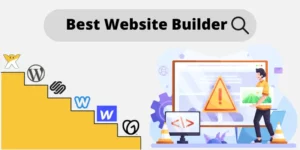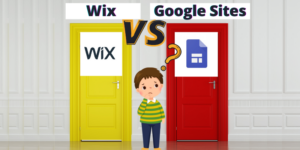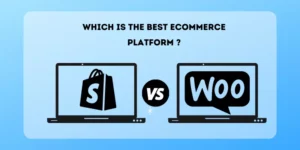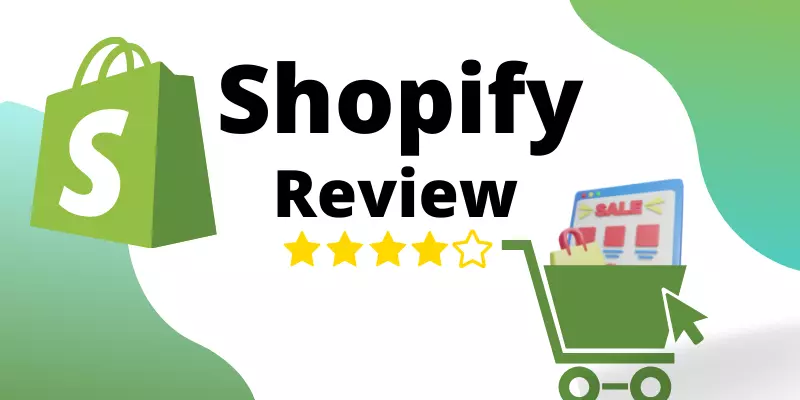
It’s a tricky decision when choosing an eCommerce platform that meets your exact requirements. Because they offer a lot of niche variety of features. We reviewed Shopify features, performance, SEO, Marketing, Speed, Hosting, and more.
Shopify Review Findings: 11 Pros and 7 Cons
Shopify Pros
- Excellent Themes for all sizes of the business.
- It has its own Integrated Shopify payment gateway (Not available for all countries), Also you can choose from 100s of third party payment gateways from almost all countries.
- Shopify has a Secure Server and Updates automatic
- Great support team is available 24/7
- Flexible with Small, Medium, and Large Business
- Easy Setup and installation of Apps
- Shopify Point of Sale features for Offline Sale
- Facilitates trade for international markets seamlessly
- Shopify app store has over 6000+ apps & most of them are above 4/5 star rating.
- Good analytics, reports, and visuals
- Scalable, Managed hosting and sudden high traffic handling capacity.
Shopify Cons
- The Pricing can be one of the issues as it is a bit high
- Transaction fees on each sale upto to 2% extra if the primary payment method used other than Shopify’s own integrated “Shopify Payments”. Also Shopify-Payments is not available in all countries.
- Checkout Customization not available in $39 plan
- Shopify page design editor is poor. You can install Page builder apps, but they are costly.
- Shopify markets option available to Shopify payments users only.
- You may need to install apps for most of the extra features. For example: Shopify limits product variants upto 100 & option per product is limited to only 3 (Size, color, material etc). You need to install third party app from its app store to get more options & features
- Some users have reported about how Shopify handles chargebacks and payment disputes, frozen funds or account holds etc can also happen in rare cases. See more details about it
Short Review
| Features | Ratings | Short review |
|---|---|---|
| Plans and Pricing | Shopify offers 3 plans, with pricing ranging from $39 to $399/month. It also has a 3-month free trail for $1. Shopify also offers Enterprise Plans starting from $2000/month. | |
| Domain & Hosting | You can buy a new domain from Shopify or connect an existing domain to your Shopify website. All Shopify sites will be hosted on its inbuilt hosting with unlimited storage and bandwidths for all plans. | |
| Themes | Shopify provides 15 free themes and plenty of paid themes ranging from $150 -$350. Other than this, You can also get quality templates from a third-party marketplace – Themeforest Shopify section here | |
| Editor | Shopify theme editor allows adding sections to the homepage and editing them for different styles, fonts, and colors. To edit special features you can take the help of the app store or do it with custom coding. | |
| Payments and Charges | Shopify has Over 70+ payment providers including PayPal, stripe, etc. There are no transaction charges for accepting payments by Shopify payments, if used any other payment provider (ex PayPal, stripe) is to take payments then Shopify charges 2% for the $39 plan, 1% for the $105 plan, and 0.5% for the $399 on each sale. | |
| Shipping and Delivery | Shopify allows Setting flat shipping rates or automated carrier rates at checkout and setting separate shipping rates for domestic and international shipping. Users can Print shipping labels straight from the Shopify dashboard. | |
| Sales Channel | Shopify sales channel integrates with eCommerce channels like Amazon,eBay, Etsy, etc., and social media channels like Facebook, Instagram, Pinterest, etc, and makes easy syncing of products, inventory, orders, etc | |
| Blogging & SEO | Shopify has an Inbuilt blog editor and good on-page SEO features. all of the pages are mobile-friendly and provide sitemaps,robot.txt, and AMP pages. | |
| Support | Shopify provides 24/7 support through live chat, phone, and email. It has an active community, a collection of blogs, and videos to provide help. | |
| App store | Shopify has over 6000+ applications for adding new features and adding automation to existing stores. | |
| Analytics and Reports | Shopify has a Good analytics dashboard, and reports providing insights on store performance. Live view option to witness present customers’ behavior on site |
In-Depth Reviewed Topics
- Plans and Pricing
- Domains Hosting
- Themes
- Theme Editor
- Shopify Dashboard
- Products
- Orders
- Analytics
- Marketing
- Discounts
- Apps
- Payments & Charges
- Shipping & delivery
- Shopify Sales Channel
- Blogging & SEO
- Shopify Support
- Multiple Marketplace selling
- Multicurrency
- Multilingual
- Tax and Import duties
- Custom Pricing
- Shopify Dropshipping
1. Plans and Pricing
Basic Shopify:$39/m
Shopify:$105/m
Advance Shopify: $399/m
Shopify has introduced a new plan or you can call it free trial – $1 for 3 month.
Shopify has Enterprise Plan “Shopify plus” which starts from $2000/month. It’s a plan for big businesses and enterprises, with this plan users can get Advance features like Priority Support, customizable checkout, and more
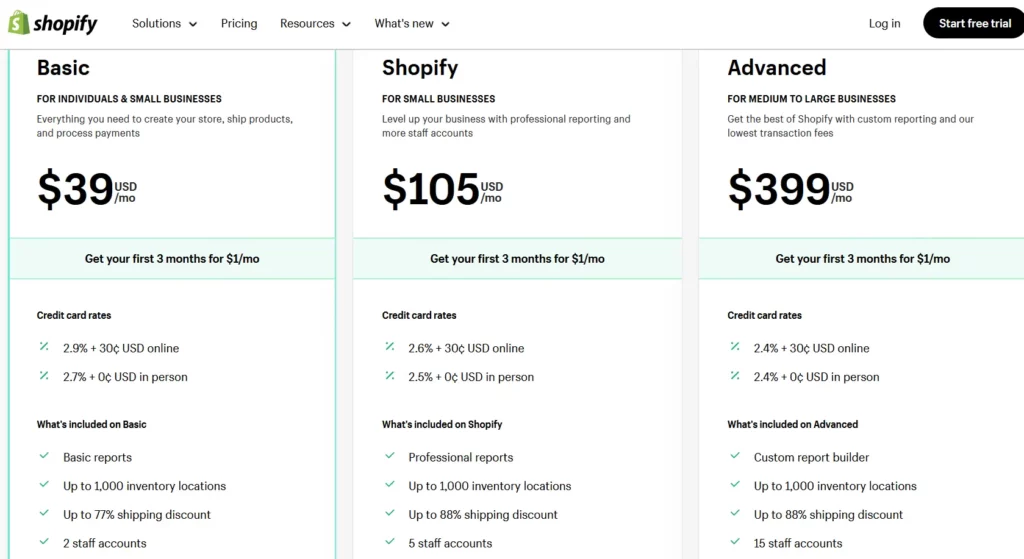
2. Domain and Hosting
#shopify domains
Shopify gives you the following options with domains
- Connect an existing domain from a third-party domain provider with 2-3 easy steps
- Completely transfer your existing domain to Shopify and it will manage your domain
- Buy a new domain from Shopify
- Buy any of the Shopify annual plans you can get a custom domain for free
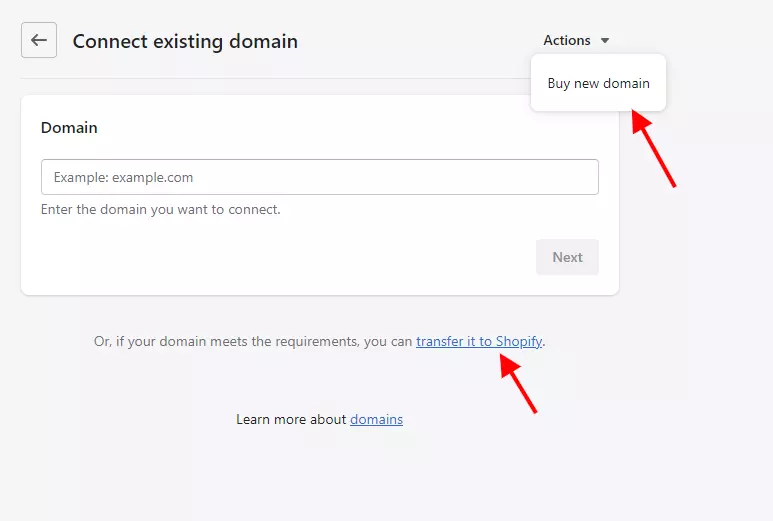
#Shopify hosting
Shopify provides inbuilt hosting with the following features
- Unlimited bandwidth & storage
- A strong SSL security layer
- Level 1 PCI compliance
- Automatic Updates on new features
- Free Custom domain on the annual plan
- Powerful CDN across the globe
- Uptime of 99.98%
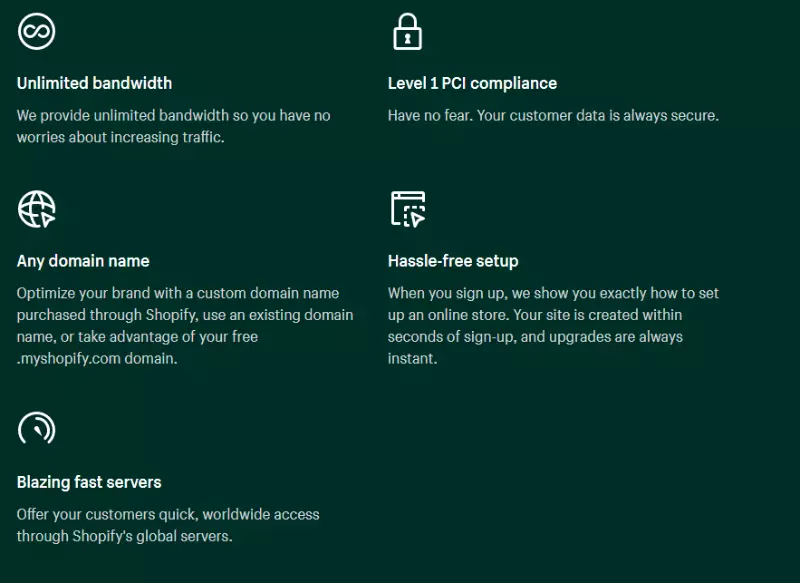
3. Theme templates.
- Shopify has beautiful templates to fit all kinds of businesses.
- It offers around 10+ Free Templates most commonly used are Debut and Brooklyn.
- If you have a good budget you can go with the paid templates that range from $150-$350.
- You can upload a theme or get a custom template done with the help of Shopify experts
- Each of the themes offers multiple styles
Shopify Themes
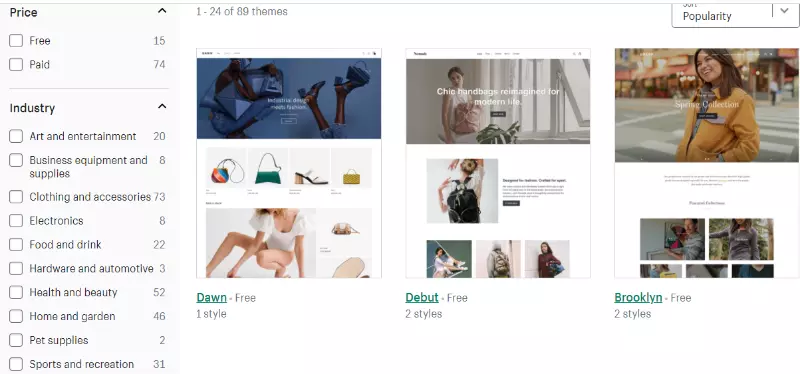
4. Theme Editor
After choosing a theme users can preview it for all devices. once the theme is installed it can be customized in the theme editor. In the theme editor users can add sections like (Featured Collection, videos, Collection page, blog, testimonials, Image Banner, etc) as shown in the image below.
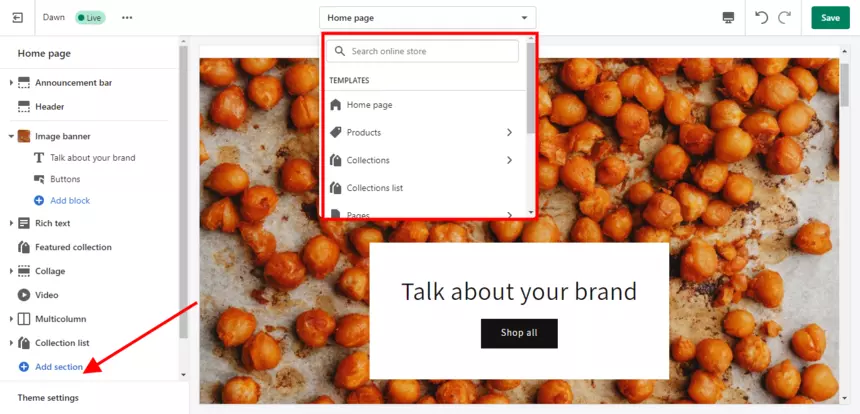
Simply click on add section & it will populate all the available sections. further, each section can be customized for different layouts. just below the sections option, you will find theme setting options to change the Fonts, Colours, Style, etc of the theme.
If you want to make custom changes to the theme elements, and sections it can be done in the code editor or custom liquid section which requires a bit of coding.
5. Shopify Dashboard
Shopify’s Dashboard Consist of Options Products, Orders, Analytics, Marketing, Apps, Customers, and Discount.
Products
The product section provides options like inventory, collections, Gift cards, and also an option to transfer inventory.
- Add products or import products in CSV to upload them to Shopify
- product section can be filled out with the title, Media(images, video,3d models), description, pricing, product variants(size, color, materials, etc.), quantity, Shipping & Customs, and SEO.
- In the inventory option, you can bulk edit products quantity, SKU, etc
- The transfer section helps in tracking inventory from the supplier to the business location
- Collection can be either created manually or Automated. In the manual option, you can browse and select each of the products, whereas the automated process creates collections based on matching conditions like vendor, tags, product type, etc.
- Gift Cards can be sold as products or issued as a form of gift code to specific customers
Shopify product dashboard
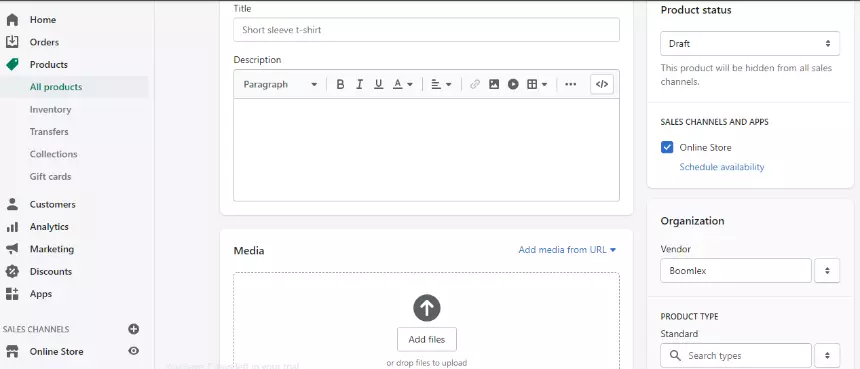
Orders
The order section provides data for Orders, drafts, and abandoned Checkouts
- The order data is important as you can manage refunds, cancellations, fulfillment, and payment stats all in one place.
- Create draft or wholesale orders for certain products and also send invoices to customers.
- Abandoned checkouts are one of my favorites option as it helps me in recovering customers who didn’t complete the transactions.
Shopify orders
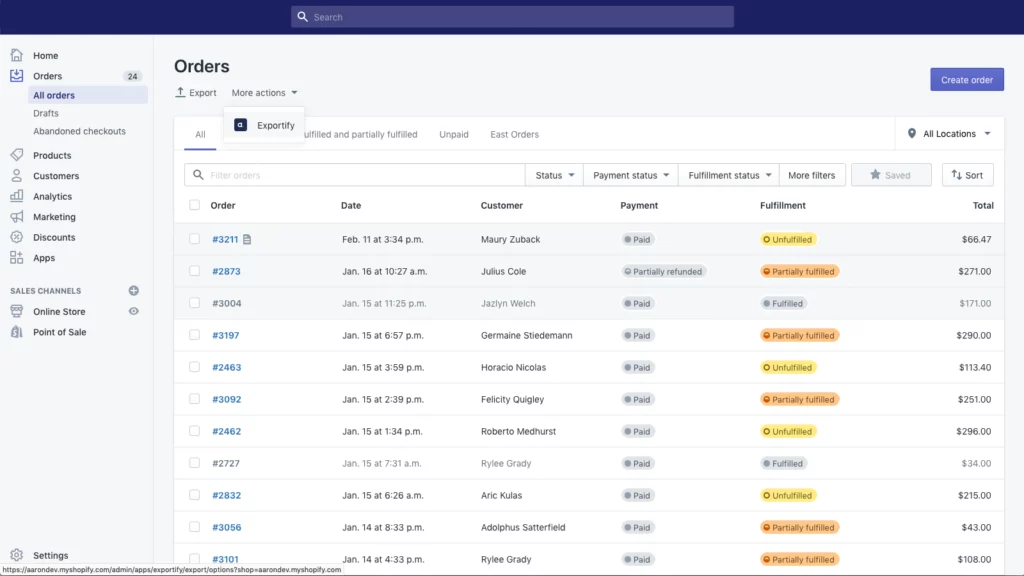
Analytics
Shopify analytics interference gives complete data around total sales, most sold, average order value, returning customers rate, customer location, session by traffic sources, etc.
Shopify Analytics
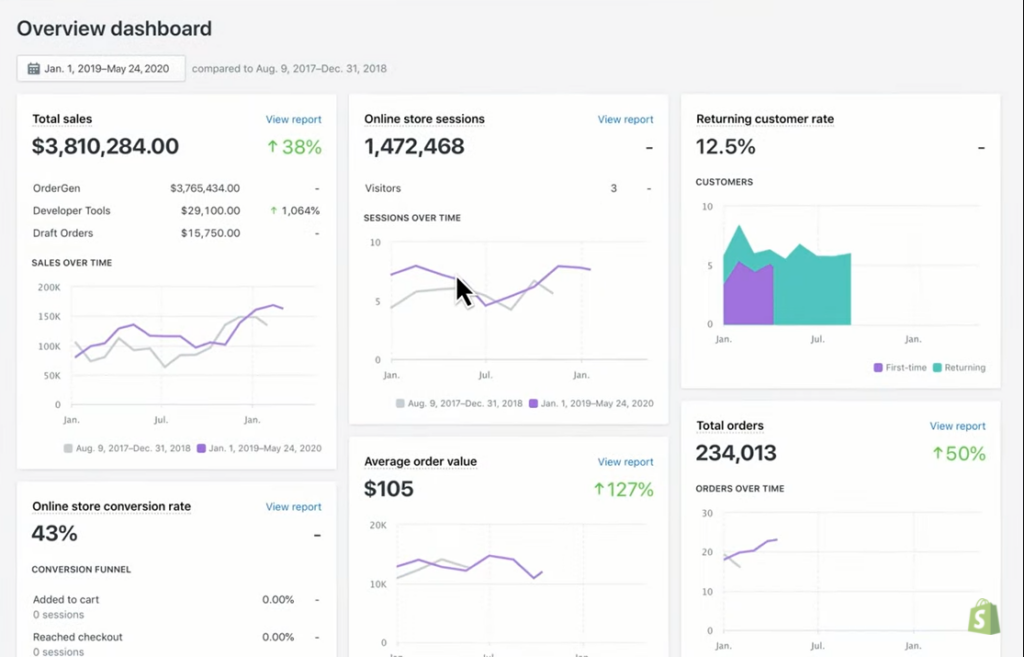
Shopify Reports
Shopify reports section is important as you can get detailed reports on parameters of sales, orders, profits, customers, acquisitions, etc. Shopify has provided basic ($39), standard ($105), and advanced ($399) reports on different subscription plans.
Shopify has limited access to reports for each of the plans
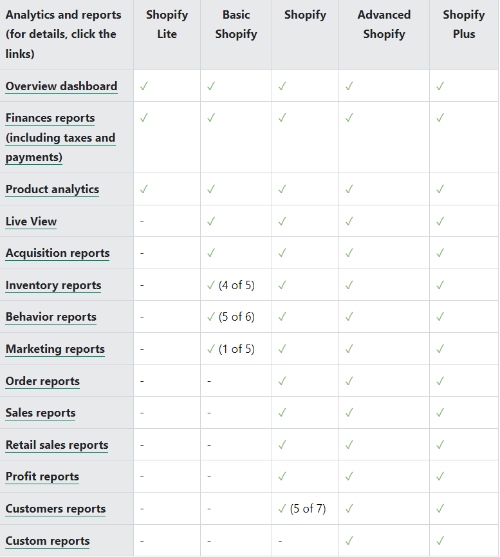
Shopify in its basic plan ($39) limits access to some of the reports on orders, sales, profit, etc & for the $105 plan limits access to custom reports as shown in the above image. if you want to get these features without upgrading to another plan, this can be done with the help of apps like Sales and Inventory Reports, and Data Export Reports which also include “custom reports” that are only available to the ($399 plan). If you want specific reports just search for that reports in-app store.
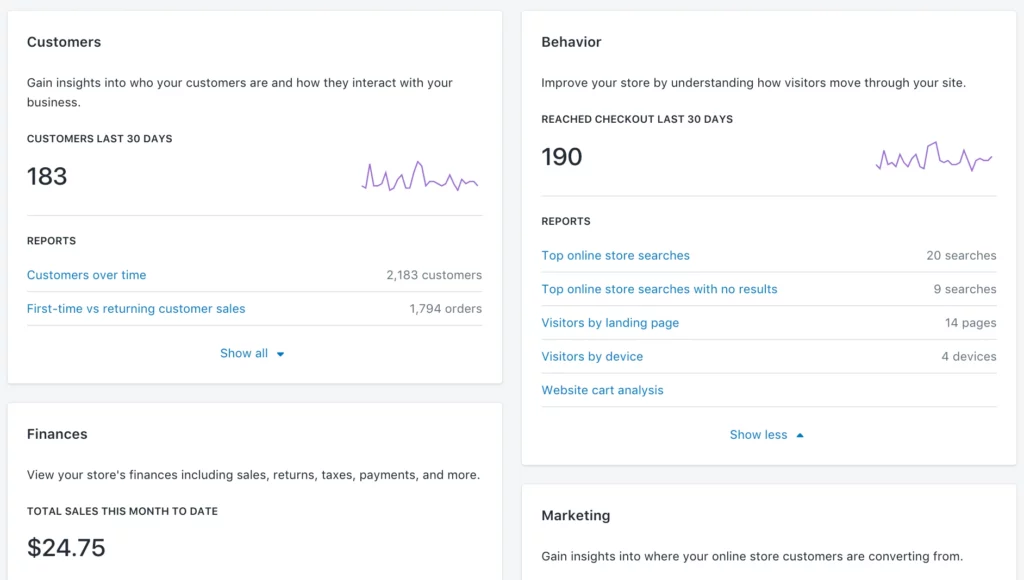
Shopify live view
Live view of Shopify is one of my favorite sections as I can witness live add-to carts, checkouts, and purchases taking place on my site from the customer all across the globe.
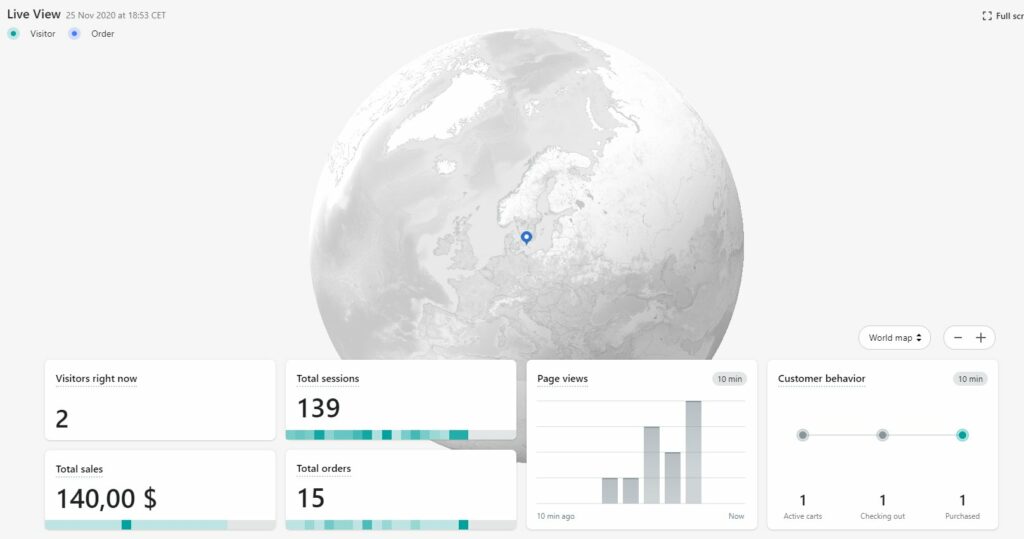
Marketing
Shopify market sections let you create Campaigns and automation from the dashboard
- Users can run ad campaigns on Facebook, Pinterest, and Snapchat by connecting these social media channels with Shopify. Users can also run and track ads straight from the campaign dashboard.
- Users can create and track automation with Shopify email for upsells, offering discounts, etc
- The marketing section also suggests some marketing apps from the Shopify app store.
- Shopify’s inbuilt email marketing tool “Shopify email” helps you in building email automation. Shopify email allows sending up to 2500 emails/campaigns. if You want to send more emails, you have to pay $1 per additional 1000 emails.
Shopify Campaigns
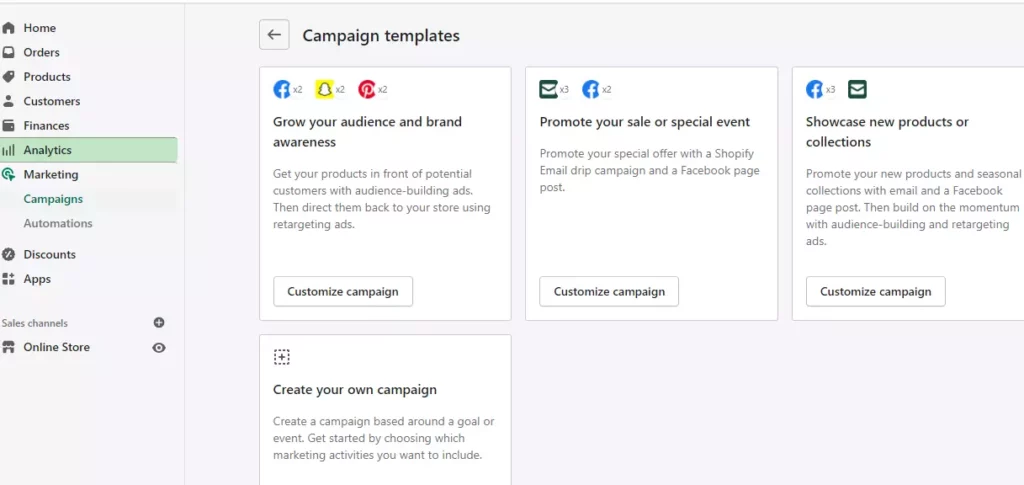
Shopify automation
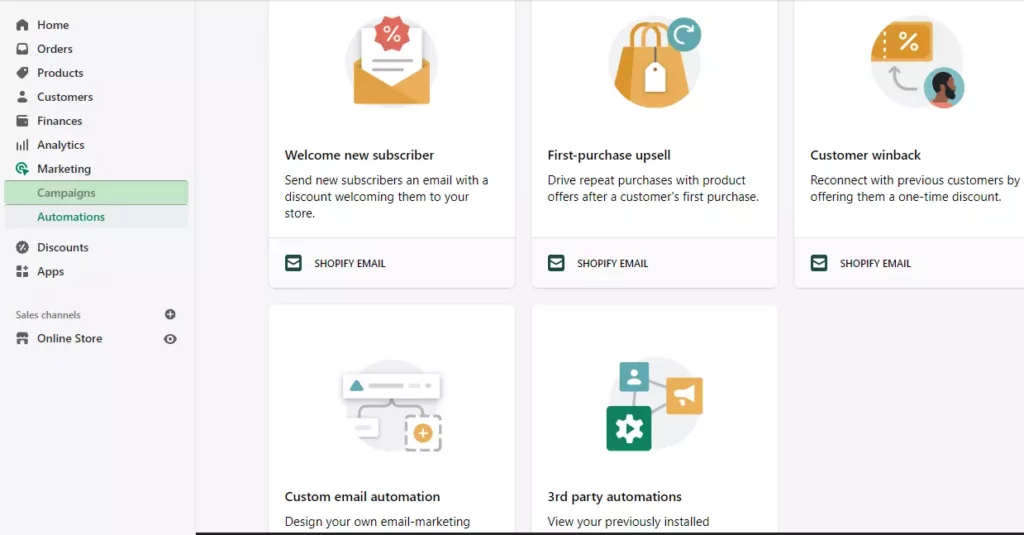
Discounts
In Shopify, you can provide discounts through discount codes and automated discounts. The discount code will activate when the customer types the code in the checkout section whereas automated discounts are applied as soon as the customer adds to the cart
Discount code
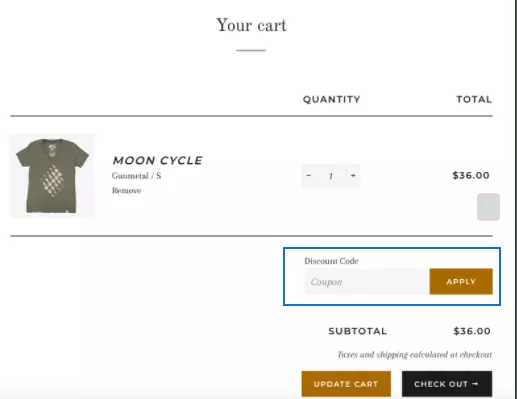
Automated Discount
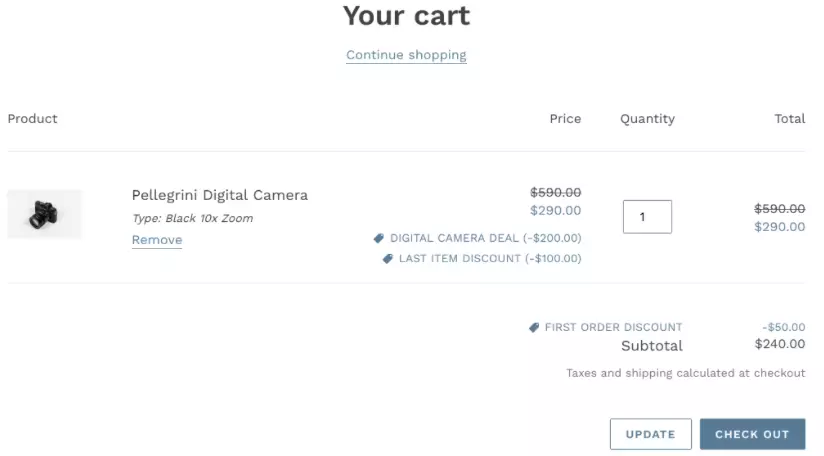
6. Apps
One of Shopify’s best features is the app store which consists of over 6000+ apps in their app store, these apps can add new functionalities or enhance the existing features of Shopify. Users can search for features’ names and it will show various apps for that feature. Users can sort apps by relevancy, free, paid, compatible with shop, POS, checkout, and more. If you want an app that can fit with a cart, checkout, or other pages you can filter for that too.
Shopify apps
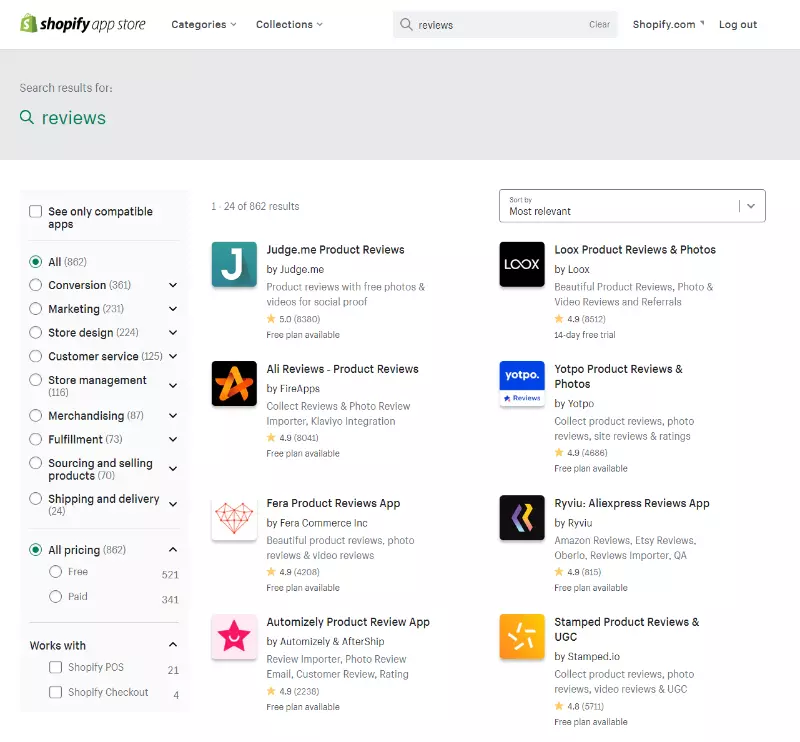
7. Payments and Charges
Shopify offers various Credit cards and payment providers for both domestic and international transactions. It has over 100+ payment options like PayPal, Stripe, iDeal, Bitcoin, etc,
Payment methods
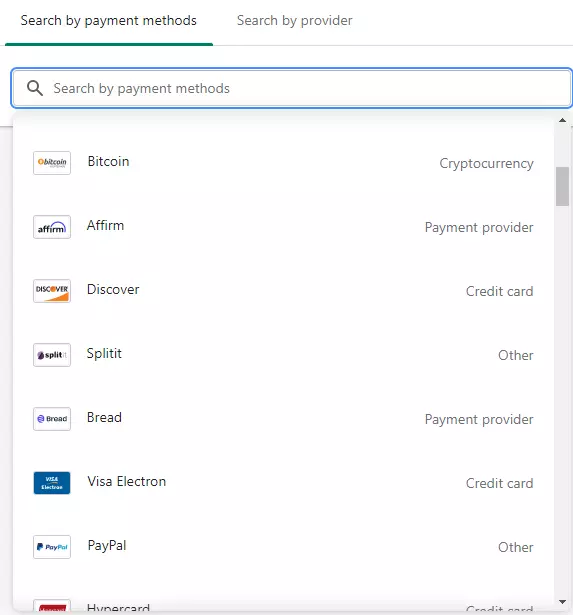
Shopify also has its own payment network called Shopify payments which accepts payments from major credit card providers like (Visa, Amex, Discover, etc) and wallets like (google pay, apple pay, and Facebook pay).
Shopify payments
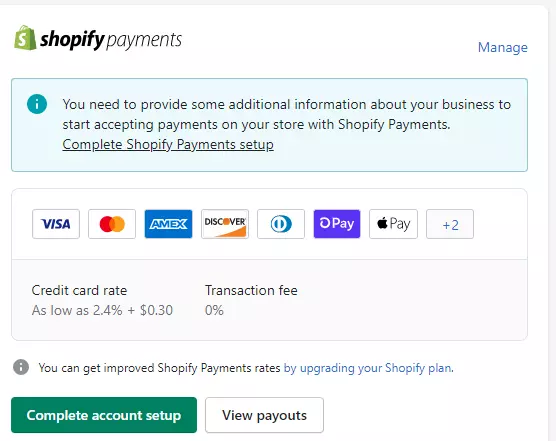
Shopify payments supported countries
- Australia
- Austria
- Belgium
- Canada
- Denmark
- Germany
- Hong Kong SAR
- Ireland
- Italy
- Japan
- Netherlands
- New Zealand
- Singapore
- Spain
- Sweden
- United Kingdom
- United States
Shopify charges transaction fees on each sale if the transactions take place on payment providers other than Shopify payments. The transaction charges for using other payment providers are 2% for the $39 plan, 1% for the $ 105 plan, and 0.5% for the $399 plan. In addition, all US merchants will pay a cross-border fee of 1% only when a buyer using a credit card issued outside of the US makes a purchase from a US store.
Shopify has fraud analysis features to report fake transactions or scams, it will provide indicators of the level of fraud and provides details on why it is suspected to be a fraudulent transaction.
8. Shipping and Delivery
Shopify has various shipping options to aid the merchants. The shipping and delivery setting provides the option to set domestic and international rates. Either you can set your own rates manually or use a carrier or app to calculate rates
Setting own rates
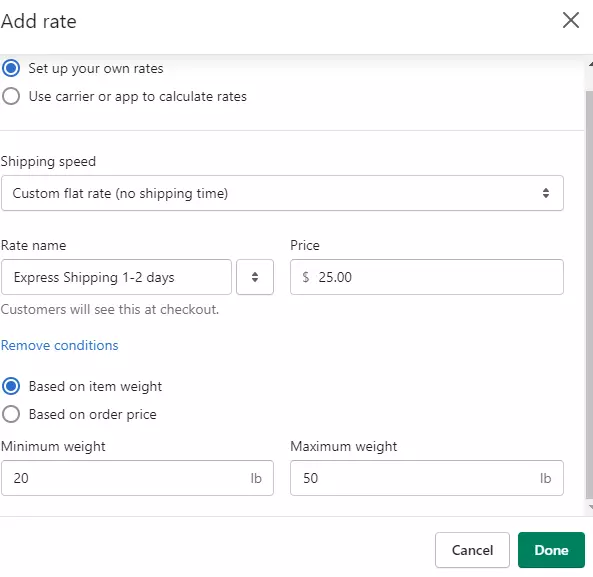
Automated Carrier rates
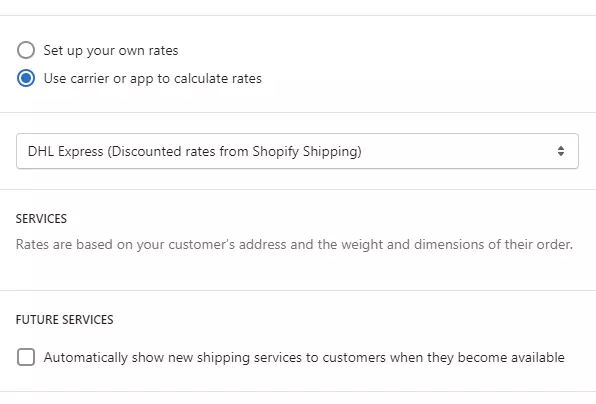
Users can also add a custom shipping rate on certain products, and offer local delivery and pickups from the warehouse location. Adding package sizes allows carrier rates to be displayed accurately at checkout. No need of standing in a queue for getting shipping labels as Shopify makes things easier by providing discounted downloadable shipping labels of DHL, USPS, and UPS right from the Shopify dashboard.
Shipping label
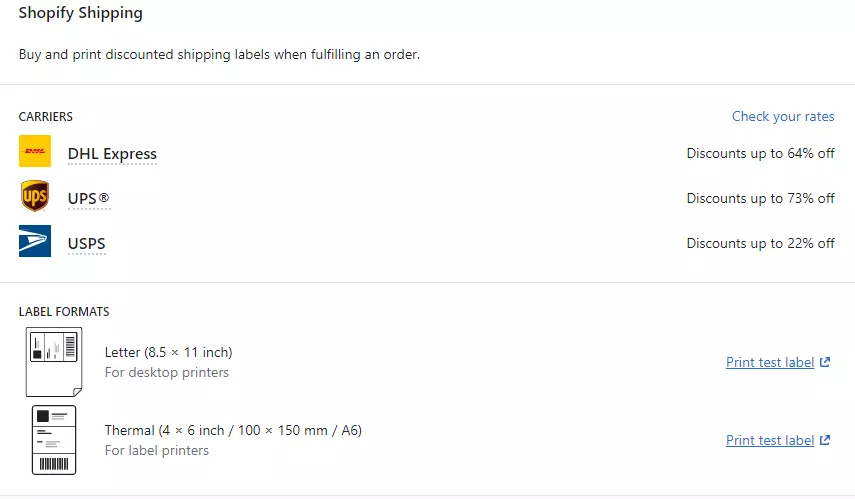
Note: The automated Carrier rates at checkout are available when you are on an advanced plan or have an annual plan with Shopify. However, you can use Shopify apps like Shipping Rates Calculator Plus ($6.99/month), Easy ship (free to install), etc to get this feature at a cheaper price.
9. Shopify Sales Channel
Shopify is a beginner-friendly platform that sets up your business easily. Shopify’s integration with various marketing channels Amazon,eBay, Etsy, etc. lets you sell more, Shopify also integrates with Social Channels like Facebook, Google, Tiktok shopping, Instagram, Pinterest, etc.
Facebook – Sell your products on Facebook shop by integrating your page
Google – List your store products on google shopping for more sales
Pinterest – If you have a Pinterest business account you can sell on Pinterest
Etsy, Amazon, and eBay are eCommerce giants so integrating your shop over there leads to more Visitors and hence sales.
Shopify multi-selling channels
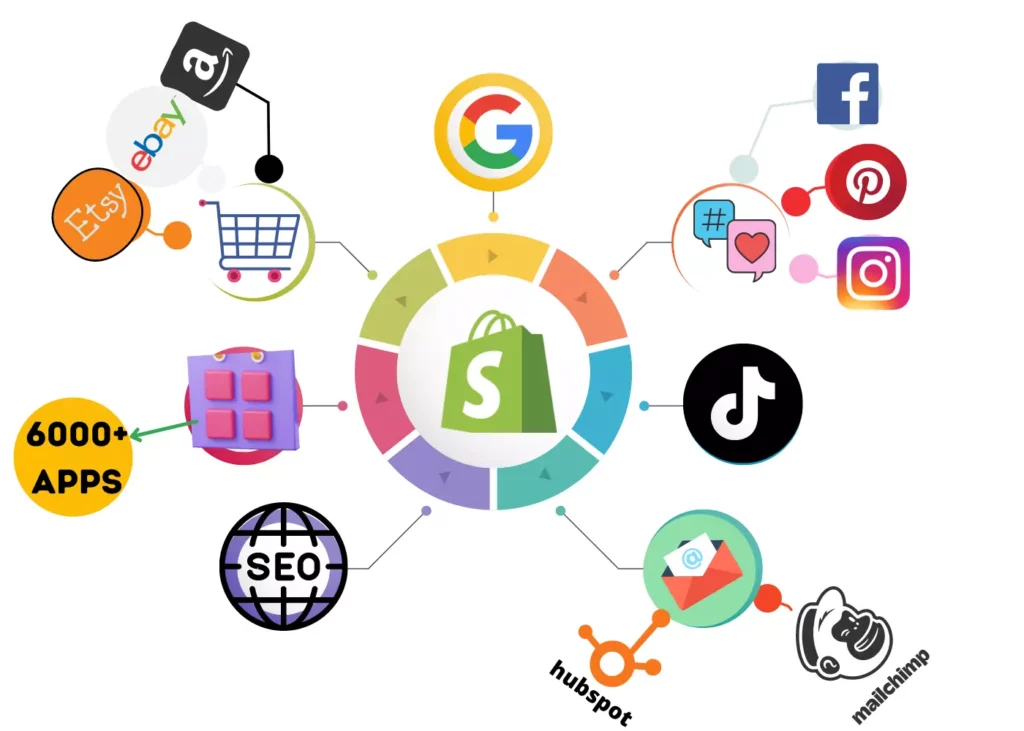
10. Blogging & SEO
Blogging features
- Blogging option – Online store > Blog posts
- Insert images, and tables, and embed videos to the blog
- Add a summary to the blog visible on the homepage
- Assign tags, type, author, and schedule of the blog
- Commenting controls on blogs
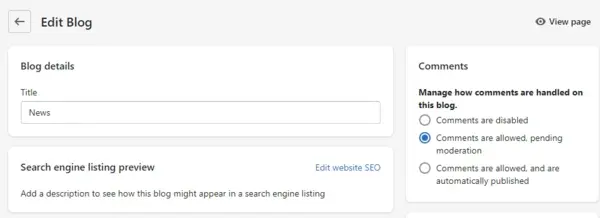
SEO features
- Basic Seo settings for every product and collection page
- Alt text for image optimization
- provides automated sitemaps and robot.txt
- Facilities 301 redirects
- mobile-friendly and provides AMP pages
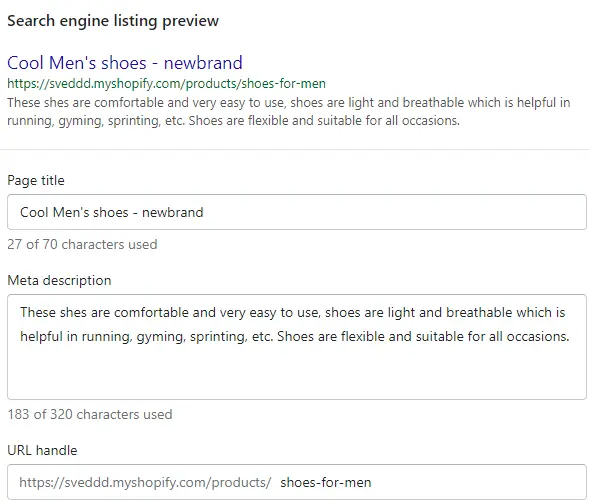
11. Shopify support
Shopify support is very responsive as they operate 24/7 to provide instant replies. They provide support in 4 ways Email, Chat, mobile, and community support. There are forums and communities for discussion. They also provided plenty of blogs and videos for reference.
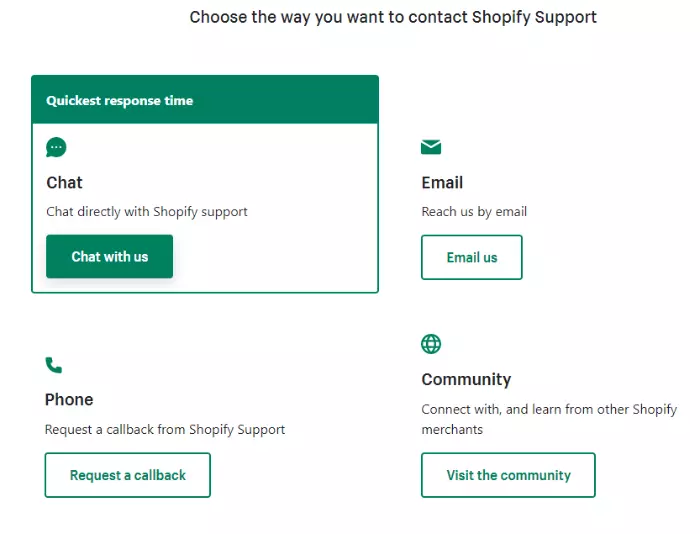
12. Multiple Marketplace selling
When you sell in multiple markets you will need the following features
Multicurrency
For businesses selling in different countries. It’s important to sell in customers’ currency for a better user experience, by displaying the currency of the customer’s country and also making him pay in his local currency. There are multiple ways to achieve this.
Instance 1: If you have Shopify payments set up in your shop. then you can access multicurrency checkout through Shopify markets. If your customers are from one of the following countries you can sell products in their local currency.
Shopify Market supported countries
Australia, Austria, Belgium, Canada, Czech Republic, Denmark, Finland, France, Germany, Hong Kong SAR China, Ireland, Israel, Italy, Japan, Malaysia, Netherlands, New Zealand, Norway, Poland, Portugal, Singapore, South Korea, Spain, Sweden, Switzerland, United Arab Emirates, and the United Kingdom.
Shopify markets
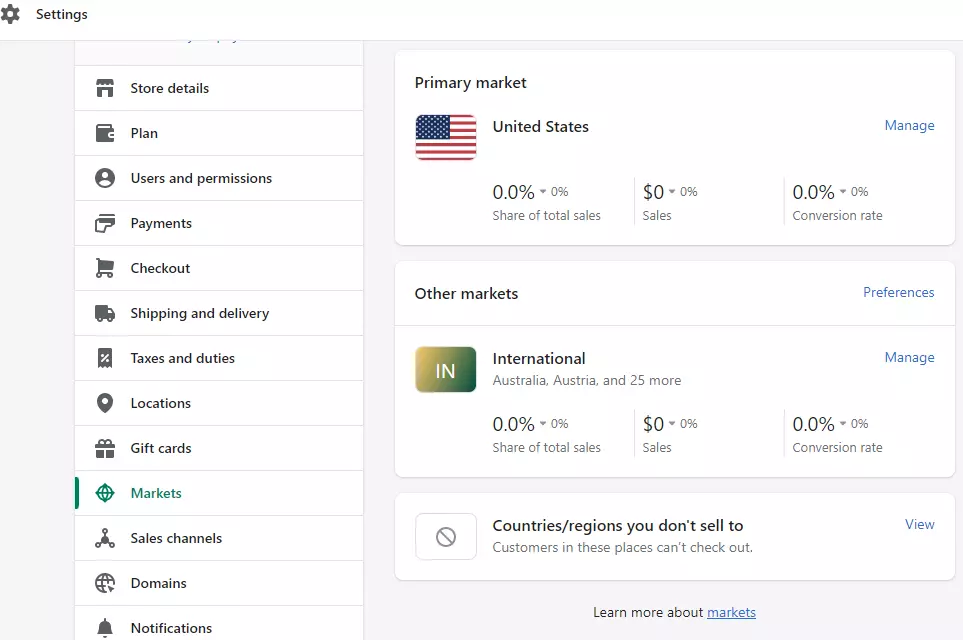
The market options allow users to manage and provide preferences to countries. users can also assign primary markets which will take your default currency. users can also block some countries from checking out. It automatically converts the default currency to the customer’s currency through the geolocation app by Shopify.

Instance 2: If you don’t have Shopify payments set up in your shop then you can’t access the Shopify markets option, but no worries multi currency converter third-party applications will help you with this. users can display the price as per the locations of the customers, but they can’t be able to pay in their local currencies. but still, this will help the customer as they will know the price they are paying.
Instance 3: If the user chooses the Shopify Plus plan then they can change the code of checkouts completely and enable multi-currency checkout. This will be good for enterprises as Shopify plus plan starts from $2000/month, and the price varies for the size of the business.
Multilingual
Showing stores content in customers’ native language provides clarity in information. Using Shopify users can convert shop languages into 20 different languages. first users need to create translated versions of the store content, and product descriptions in the languages they want to display and upload them Or else users can use Shopify translation apps to translate store content.
Once you upload store content in different languages, Shopify will create different URLs for different languages ex: shop.com/es for Spanish. once the customer lands on the site they will be redirected to the URL of a specific translated page based on user location. If there is no translation available then the default language will be shown.
Shopify Multilingual options
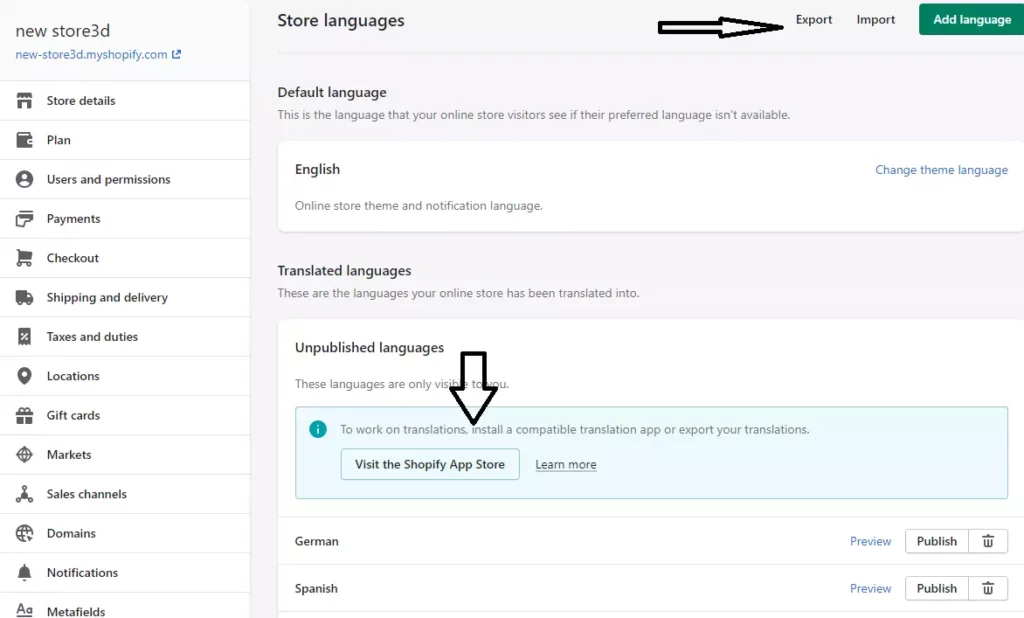
Users can import translated CSV files and add them in this section. Checkout official Shopify blog to check the requirements for multilingual translation
Tax and Import duties
Taxation is an important part to manage finance and billings which can also affect profits. In Shopify, users can manage international and domestic tax rates and also charge import and duty fees.
Ways of collecting taxes
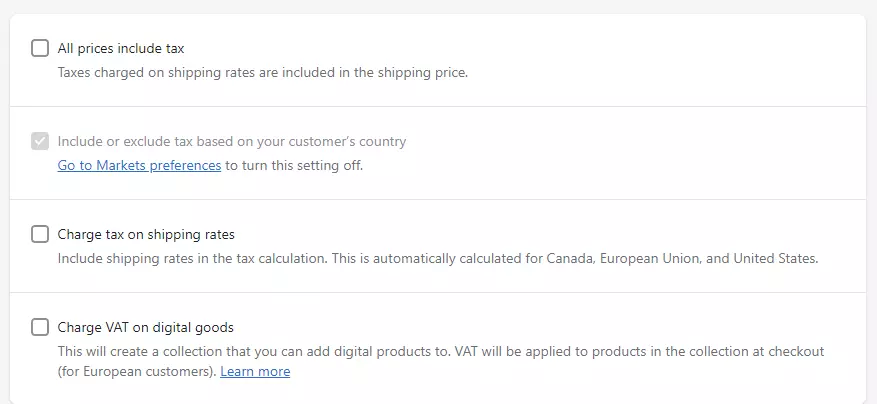
It provides settings for domestic and international rates. for domestic tax settings, users can collect taxes separately for different states and also have the option to override taxes on certain products and collections.
If you sell internationally Shopify has covered necessary tax settings. users can set up location-based tax rates. Shopify users on the advanced plan($399) can collect import duties charges and taxes for countries/regions.
Custom Pricing
While selling in the international market some products might have different values in different regions and parts of the world. Shopify custom pricing allows you to take control of setting specific prices for different products and variants in each of the markets. This setting is available from the advanced plan($399).
13. Shopify Dropshipping
The new model of dropshipping business is been eased by Shopify. It integrates with lots of dropshipping suppliers like Oberlo, Aliexpress, and CJdropshipping. These applications provide inventories, manage all your orders and fulfill them on your behalf so you can concentrate on growing your business. There are apps that facilitate print on demand, you don’t need to worry about inventory storage, and shipping all of this will be taken care of by them. you can also find suppliers from all over the world.
Shopify dropshipping
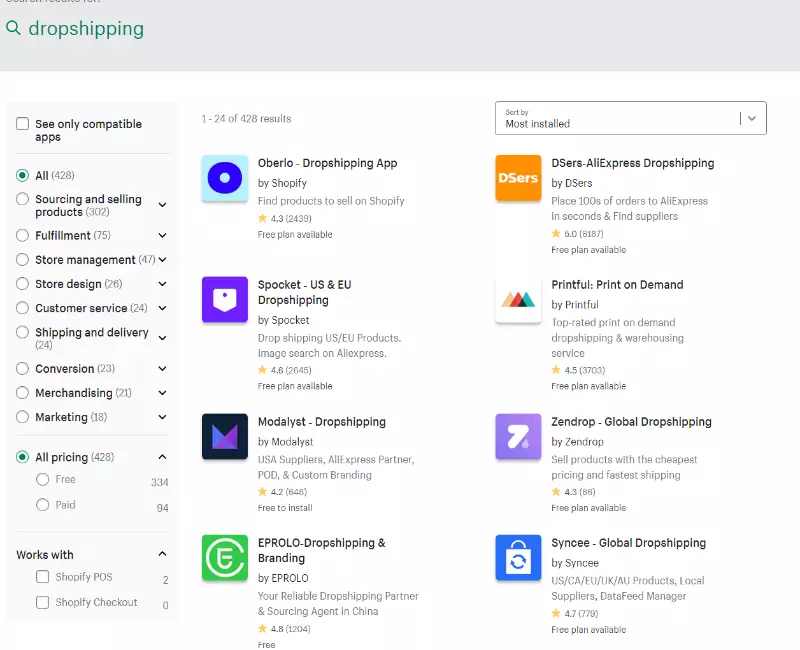
Summary
Shopify setups shop in no time as it has inbuilt hostings and included SSL so you avoid buying it from another hosting provider. Shopify’s Cloudflare hostings are the best as they can host and provide unlimited storage for all kinds of businesses at the same plan. You can buy your domain from Shopify or just connect or transfer an existing domain to Shopify. With no Coding knowledge and design aspects, you can provide a professional look to your shop. Shopify has well-structured Sections and is mobile Responsive which benefits User Experience (which Google considers an aspect of SEO). By Using Shopify Live insights, reports, and Analytics tools you can understand customers’ behavior and allow you to fill the marketing gaps.
Shopify provides Smooth Integration with Marketing Channels Facebook, Instagram, Google, and Amazon which helped me Reach to wider Audience and hence sell more. The best thing about Shopify is the flexibility and variety of options it provides as your business grows from small to medium business. Every time I had some problem, I used to ask Shopify support and they resolved it most of the time their community is really helpful.

Declan Kingston mainly works around strong Data to create powerful visuals, complex graphs to make the right decision for companies. He has been working in this field for over 8 years, has a strong knowledge of eCommerce platforms and website builders. He has worked with Ethereum and Looker Data Sciences, Inc. (now part of Google Cloud).
